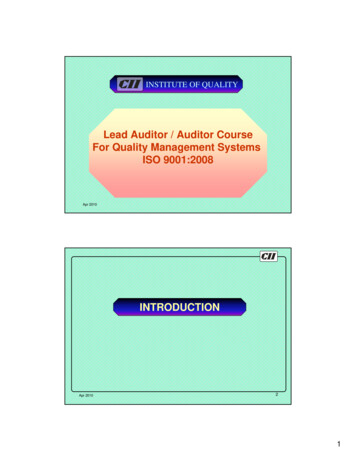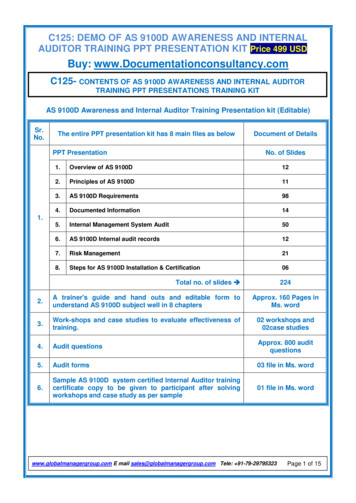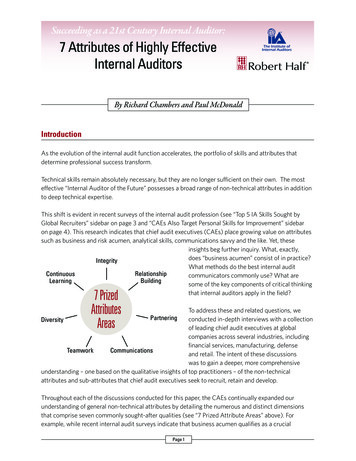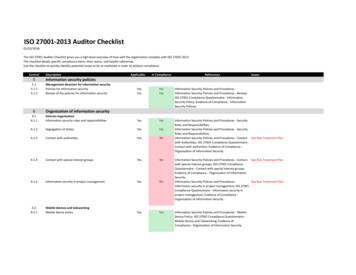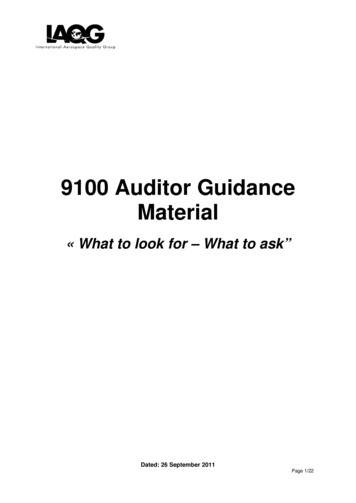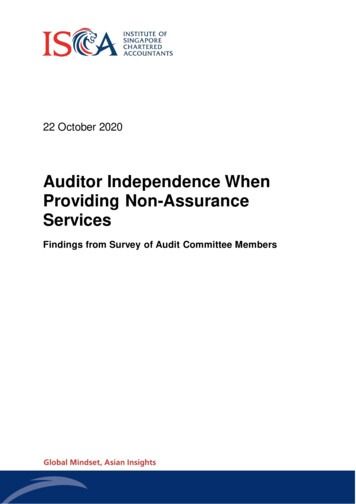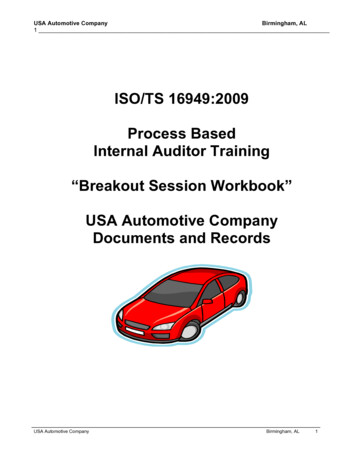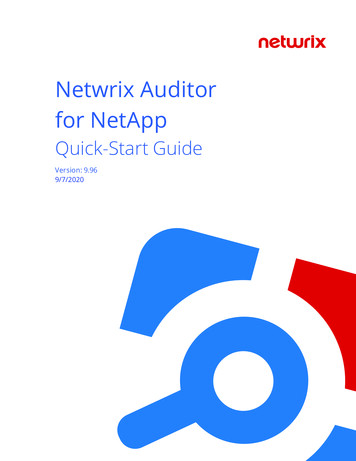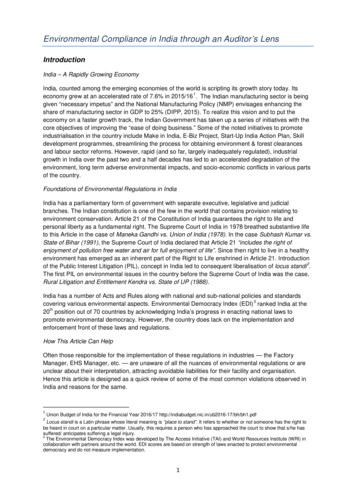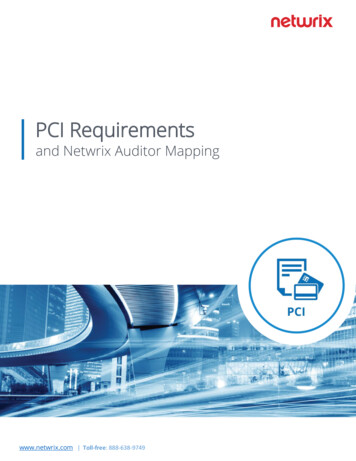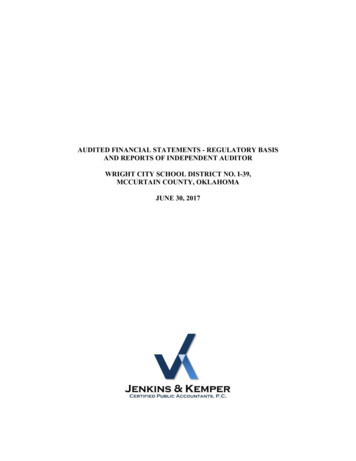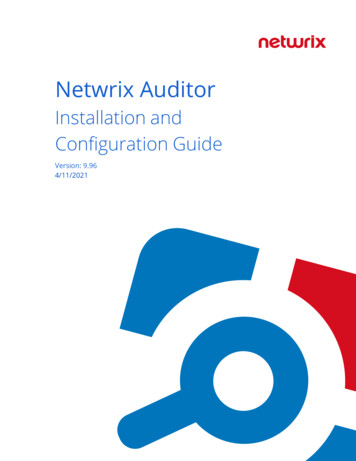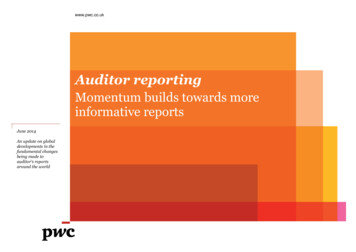
Transcription
www.pwc.co.ukAuditor reportingMomentum builds towards moreinformative reportsJune 2014An update on globaldevelopments in thefundamental changesbeing made toauditor’s reportsaround the world
ContentsEnhanced auditor’s reports – the momentum is building1The key changes in brief2How the proposed and new reporting models compare3Looking more closely at the new UK reports4Reactions from stakeholders7Timing of the various proposals and developmentsMomentum builds towards more informative reports10PwC Contents
Auditor reportingEnhanced auditor’s reports – the momentum is buildingThe debates that will shape the auditor’s report of the future are moving forward, and the look and feel of thenew enhanced reports are starting to crystallise.“Relevant reports on financial statementsfrom a relevant profession – that’s what isat stake here.”Michael de Ridder,PwC’s Netherlands Assurance LeaderAuditors in the UK have now been through the first reporting season using the new UK Financial ReportingCouncil’s (FRC) requirements for enhanced auditor’s reports, and feedback from stakeholders on the new reportsis starting to emerge. PwC and other firms in the Netherlands voluntarily piloted the International Auditing andAssurance Standards Board (IAASB)’s proposed new model in some of their 2013 year-end audit reports. Wehave also field-tested the IAASB and US Public Company Accounting Oversight Board (PCAOB) proposals.These are important developments. With changes as fundamental as this, going beyond discussing the proposalsin principle to get insight into how they will work in practice is important.If there had been any doubt, it is clear now that the audit reporting model will change – at least for listedcompanies. While many preparers have reservations, investors welcome what they recognise is a ‘sea change’,and auditors are on a learning curve.This booklet provides an overview of the developments, the reactions so far and some of the questions that arestill being debated.Momentum builds towards more informative reportsPwC 1
Auditor reportingThe key changes in briefThe changes that different standard setters and regulators are introducing to auditor’s reports centre aroundthree key aims: insight, transparency and improved readability.Insight“This innovation in auditor reporting isradical, a ‘step-change’ as some havecalled it. It makes the auditor’s workmore transparent and relevant to users.It stimulates public debate and analysison what auditors’ reports are mosthelpful. In other words, the auditor isback on the Public Forum – where theRoman name ‘auditor’ comes from: firstlisten, then speak out in public whereimportant.”Arnold Schilder,Chairman,IAASBWithout doubt, the most significant innovation in all of the various proposals is the introduction of ‘key auditmatters’ (IAASB), ‘critical audit matters’ (PCAOB) or equivalent concepts. This new section of the auditor’sreport will shed light on those matters that, in the auditor’s judgement, were of most significance in the audit ofthe financial statements. How the requirements (or proposed requirements) are described differ, but the intent issimilar – to introduce into auditor’s reports a bespoke description of key areas of focus in the audit. This is notsupplanting the auditor’s overall opinion on the financial statements as a whole – which investors value and donot want to lose. But the reports will be enhanced by the auditor’s descriptions of key audit matters or criticalaudit matters – sharing insight, from an audit perspective, about more subjective areas in the financialstatements, such as complex financial reporting estimates and significant management judgements.TransparencyIn the IAASB proposals, the main proposals designed to enhance transparency are to introduce an explicitstatement regarding the auditor’s independence and to identify the engagement partner’s name. Both are alreadyincluded in auditor’s reports in many parts of the world, but it is not the practice everywhere.The PCAOB is proposing, and the EU Audit Regulation will require auditors of public interest entities, to disclosethe auditor’s tenure – the year that the auditor began serving consecutively as the company’s auditor. Both alsorequire a statement on independence.ReadabilityChanges being considered to improve the readability of the auditor’s report include restructuring the report toput audit- and entity-specific information earlier in the report – in particular, putting the audit opinion first(IAASB). The UK FRC and the IAASB also both allow much of the standardised wording in the report (e.g., thedescriptions of the auditor’s responsibilities and what’s involved in an audit) to be placed either in an appendixor included on a common website (such as that of a regulator or standard setter).Momentum builds towards more informative reportsPwC 2
Auditor reportingHow the proposed and new reporting models compareStage of developmentIAASBUS PCAOBUK FRCEU audit regulationPositions as of the June2014 IAASB meetingAugust 2013 proposedstandardJune 2013 standard ineffectFinal approvedrequirementsAuditor’s report element (for listed company audits)Prominent placement of the auditor’s opinion and other entity-specificinformation Key audit matters/critical audit matters/audit risks: Identification of the matters/risks Description of how the audit responded to those matters/risks Description of the outcomes/findings Guidance suggests theymay be included Not required but has beenincluded in a few reportsKey audit input judgments, including materiality and group scopingConclusions regarding going concern Required where relevantRequiredProposed enhanceddescriptions ofresponsibilitiesNo change to extantmodelNot required but havebeen included by somefirmsStatement regarding the outcome of auditor’s consideration of ‘otherinformation’ (e.g., the front half of the annual report) Statement regarding the auditor’s independence Reference to therequirement to beindependent Not in the auditor’s reportbut included in the reportby the audit committee onits work Disclosure of the year the auditor began consecutively serving as the company’sauditorIdentification of the engagement partner’s nameMomentum builds towards more informative reports Being addressed in aseparate project No change to extantmodel PwC 3
Auditor reportingLooking more closely at the new UK reportsThe new UK audit reporting requirements came into effect in Q4 2013. So, in audit reports issued on Septemberand December year-ends, auditors have been required to: Describe the risks that had the greatest effect on the overall audit strategy, the allocation of resources in theaudit, and directing the efforts of the engagement team. Explain how the concept of materiality was applied in planning and performing the audit. Provide an overview of the scope of the audit, showing how it addressed the risks and materialityconsiderations.The requirements in the new ISA 700 (UK & Ireland) were pitched at quite a high level – prescribing the mattersthat should be included but not how they should be reported. As a result there has been a lot of experimentationin the approaches to adopt both the content and presentation of the new reports – between audit reports fromdifferent firms, and even between auditors in the same firm.Note that neither the IAASB or US PCAOB are explicitly requiring auditors to describe audit input judgements –such as materiality and group scoping – in all auditor’s reports, nor will they be required in EU audit reports, sothose requirements are unique to the UK.As a result there has been a lot of experimentation in the approaches to adopt both the content andpresentation of the new reports – Between audit reports from different firms, and eMomentum builds towards more informative reportsPwC 4
Auditor reportingAudit opinion positioned at thebeginning of the report ratherthan at the endPlain English headings and lessstandardised language‘Overview of our audit approach’‘What an audit involves’‘Our opinion’‘What we have audited’Overview of audit approach,including the approach to theaudit of the group andmateriality judgementsMomentum builds towards more informative reportsPwC 5
Auditor reportingBespoke descriptions ofareas of particular focus inthe auditExtract from PwC’s audit report toshareholders of TUI Travel PLCTypes of matters reported bydifferent auditors as areas offocus Property valuation and impairment Goodwill impairment Acquisition and disposals ofoperating activities Inventory valuation Revenue recognition Pension accounting Claims & litigation Taxation (deferred and current) IT environment and controldeficiencies Management override of controlsMomentum builds towards more informative reportsExtract from KPMG’s audit report toshareholders of Rolls Royce Holdings PLCPwC 6
Auditor reportingReactions from stakeholdersReactions from stakeholders to the new UK audit reports have so far been positive. In addition to the positivereaction of representatives of the UK FRC, investors refer to what they see as a ‘sea change’ and welcome the shiftto more insightful reports. It’s a good start and is reflecting well on the profession.“I have been encouraged by theenthusiastic response of the auditingfirms to the challenge set by the newrequirements. It is already clear that therequirements are not giving rise toexcessive boilerplate or legalistic auditreports. In many cases, the auditor’sreports seem quite frank and open abouttheir discussions .”Nick Land,Chairman,UK FRC Audit and Assurance CouncilMost of the new reports are seen as including useful, tailored and informative descriptions. That said, thechallenge in keeping the reports ‘fresh’ in future years is readily acknowledged. Investors have also reactednegatively to wording that they see as just adding boilerplate. They are looking for bespoke descriptions that aretailored to the particular circumstances of the audit and the entity. A good report, in their mind, is one where youcan cover the name of the company and still be able to tell what industry the company is in, and even perhapswhich company it is.Areas of focus – How far to go in describing findings?When asked about what they find the most valuable in the new reports, investors inevitably point to thediscussion of risks/areas of focus.The report that has captured the most attention is KPMG’s audit report for Rolls Royce (see extract on theprevious page). This was one of three reports issued by KPMG with findings, all of which were issued by the samepartner. In the six-page report on the Rolls Royce Holdings plc financial statements, the auditor discusses anumber of risks, describing for each: the risk, the response to it in the audit and the findings – including, forexample, the auditor’s own view on whether estimates and management’s judgements had been ‘balanced’,‘mildly cautious’ and ‘acceptable but mildly optimistic’.Investors say that they want to hear the auditor’s perspective on risks. Most of the reports so far identify the risk,explain why it was important and describe how the audit addressed it – which in some is quite concise, in othersmore descriptive. While investors have welcomed that insight, they found them incomplete without the auditorgoing further to describe the findings or outcome. They want to hear what the auditor found and, to manyinvestors, the Rolls Royce report shows that it is possible to provide that information. It is the report that manyinvestors point to as being, in their view, best in class so far.Momentum builds towards more informative reportsPwC 7
Auditor reporting“Investors do not want a list ofprocedures. They want to know what thekey risks are, why they are key risks,how the auditor responded to them andwhat he found.”Liz Murrall,UK Investment Management Association“One benefit of the new reports is theclear demonstration that earningsnumbers are subject to manyassumptions and estimates and thatradically different numbers could bepermissible. That is not news to auditors,but it may not be well understood bymany investors.”Floyd Norris,International New York TimesMomentum builds towards more informative reportsThis is, however, in contrast to what we heard from preparers and audit committees in our global field-testing.Many preparers and audit committees in other parts of the world – particularly those where there has not beenthe same push from the investment community to reform auditor reporting – expressed nervousness, if notsignificant concern, about the nature and extent of the information that might be reported by auditors. To theextent that investors sought additional information, they challenged whether it is appropriate for auditors to bedoing that reporting. Specific concerns expressed included: The auditor might become the original source of information or exercise undue influence on whatmanagement chooses to disclose. Investors and markets might have an unwarranted negative response to the information – something thatcould be exacerbated if there is not consistency in auditor judgements about what to report in similarcircumstances. It might not be possible to convey complex matters in summary in the auditor’s report in a meaningful way;such descriptions may quickly revert to boilerplate and lose their value. Friction over what should and should not be included in the auditor’s report would have a chilling effect onthe openness of dialogue between auditors, management and audit committees.Clearly, there are many questions yet to be debated, including the subjectivity involved in providing auditor’sviews on outcomes and how the words used to describe them might be interpreted. Investors say theyunderstand that they are the auditor’s individual views. In conversations, some have said that if auditors wereprepared to provide not only insight into key risks and how the audit addressed them, but also what they foundand their views about the company’s financial reporting, they would be prepared to discuss legal safe-harbourprotections. Particularly in litigious environments, this may be key if the new enhanced reports go as far asinvestors would like.PwC 8
Auditor reportingNone of this will happen of its own accordThe positive reactions to the new enhanced auditor’s reports from investors and other stakeholders providecomfort that the new reports are heading in the right direction. The new reports are being read with interest, andthe bespoke narrative and transparency is proving to respond well to the type of insight from the audit that userswere seeking.Our field tests, pilots and first-year implementation have shown us the challenges involved in implementingthese new enhanced auditor’s reports. This is, after all, the most fundamental change in auditor reporting indecades. There will undoubtedly be a learning curve. Certainly, we are listening carefully to what is being said,and reflecting on how best to achieve the aim of embracing the new model with informative, user-friendly andappropriately focused reports. Some of the lessons that we have learned so far include:Momentum builds towards more informative reports Begin with the end in mind. The auditor’s report may be the culmination of the audit, but auditors needto be thinking about the auditor reporting process from the very outset of the audit. A good audit starts withgood risk analysis and scoping, and that’s the starting point for reporting too. Anticipate the time involved. The reports will need to go through multiple iterations and review – thatneeds to be factored into the audit planning. Keep in mind that discussions on the audit report may leadmanagement to decide to enhance or change their disclosures too. It is the auditor’s report, but management and audit committees are keenly interested. Theselection of ‘key audit matters’ begins with the matters discussed with the audit committee. That is animportant starting point. Audit committees are also engaging early and, in most audits, we have found thatdiscussions on what the audit report might look like and the matters it might discuss start very early in theaudit process, with a number of conversations taking place before the reports are ultimately finalised. Getting the ‘key audit matters’ right is a very challenging task. Most auditors intuitively knowwhich matters are the most significant and would be of interest to stakeholders. They will differ from entityto entity. But then it is important to be able to describe them clearly, being precise about what the particulararea of focus is, clearly articulating why the audit focused on it and how the audit addressed it. It is not aseasy as it sounds. Write with the audience in mind. The challenge is to draft succinct key audit matters that address thetechnical aspects in language that is understandable to stakeholders. We have found that this is an iterativeprocess that needs to be critically reviewed from outside the audit team, including the engagement qualitycontrol reviewer and the central audit technical team.PwC 9
Auditor reportingTiming of the various proposals and developmentsNew UK audit reportingstandard becomeseffective for reportsissued after 1 Oct 2013IAASB Exposure draftJuly 2013PCAOB ProposedstandardAugust 2013Some auditors in theNetherlands decide toissue reports on theirDec 2013 auditsfollowing the IAASBProposalsResponses to the IAASBand PCAOBconsultations submittedNovember andDecember 2013,respectivelyNew style audit reportsexpected to be requiredin the Netherland for 31Dec 2014 audits of atleast listed companiesPCAOB RoundtableApril 2014New EU Audit directiveand regulation approvedApril 2014, to befollowed by memberstate implementation by2016Final ISAs planned to befinalised byQ4 2014So far, proposedeffective date for boththe IAASB and PCAOB isthe 31 Dec 2016reporting period (i.e.,reports issuedin 2017)In closingIt has proven to be immensely positive that the UK FRC and the audit professionin the Netherlands have taken the bold steps of implementing the new reports.While there is a high degree of consistency in the various requirements andproposed requirements, it is increasingly likely that there may well end up beingat least some differences in the reporting requirements (EU, IAASB, PCAOB, UK),Momentum builds towards more informative reportsat least in the short term. That may not be a bad thing. We are all on alearning curve, and experimentation is valuable to get the model right.Ultimately though, convergence is desirable. Investors operate in a globalmarket and many investors and other commentators are urging consistencyin the reporting model globally.PwC 10
Who to contactFor further information please enquire of your usual PwC contact or the Auditor Reporting Project team:Diana HillierMarc PanucciT: 44 (0) 20 7804 0472E: diana.hillier@uk.pwc.comT: 1 (973) 236 4885E: marc.a.panucci@us.pwc.comJamie ShannonT: 44 (0)141 355 4225E: jamie.shannon@uk.pwc.com 2014 PricewaterhouseCoopers LLP. All rights reserved. In this document, "PwC" refers to the UK member firm, and may sometimes refer to the PwC network. Each member firm is a separatelegal entity. Please see www.pwc.com/structure for further details.140609-164956-JM-OS
Auditor’s report element (for listed company audits) Prominent placement of the auditor’s opinion and other entity-specific information . investors refer to what they see as a ‘sea change’ and welcome the shift to more insightful reports. It
